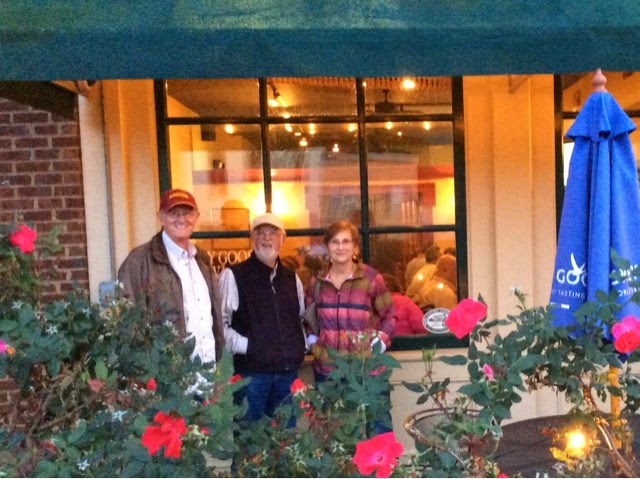But one interesting thing in this part of the country (Ohio, Indiana and Kentucky) are the decorations on the outside of many of the barns, known as hex signs. There are two schools of thought on the hex signs. Some believe they originated as purely decorative expressions of the Pennsylvania Dutch, and others feel that they were a talisman to protect against evil spirits. Modern day hex signs look much like quilt blocks and add a burst of color to the barns in the countryside. Here are a few for you:
Some barns have murals painted on the side as well...some for decoration and some for advertisement .
And some are just beautiful old barns:
One more (totally unrelated) sight I saw from the car is my favorite spare tire cover of the whole trip. It made me smile....and think of Hawaii:
Yesterday (Friday) afternoon, we set up our camp along a lovely canal from the Kentucky River.
I love this shot with the fall leaves slowly riding the current downstream:
We came here to visit our friends from Kerrville, Pete Huey and Barb Taylor. They were in our small group Bible Study from church in Kerrville. Shortly after we left on our trip, they came to Kentucky, where Pete is spending a year teaching Accounting at Midway College. What fun it was to reconnect with them! After we had some appetizers in our camper, the four of us went to Pete and Barb's (henceforth P&B) favorite Friday night pizza place. We haven't had pizza in ages, and it was delicious!
Today, Saturday, Curt and I drove over to the place that P&B are renting for the academic year. It's stunning! It was formerly a Bed & Breakfast, so it's beautifully furnished, and it's situated on a gorgeous horse farm. The boundaries have fallen for them in pleasant places! Here's some of the scenery near and at their house, which is the upstairs portion of the house in which the owners live.
In a bit I'll tell you more about that rock fence in the above photo.
Here's the view of the garden from the dining room window:
Some of the horses which P&B are encouraged to ride:
The four of us piled into P&B's car and we took a beautiful scenic drive through the Kentucky countryside to the former Shaker Village of Pleasant Hill.
If you don't know about the Shakers, they were a devout Protestant Christian people who lived in communities in the Eastern United States. The Pleasant Hill group reached their peak of almost 500 members in the mid 1800's. They lived communally, as brothers and sisters. They did not marry or bear children, so the only way their communities could grow was through converts. Sometimes whole families converted to the Shaker sect, so there were children in the communities, but they lived in separate houses from their parents. When they reached age 21, they had to make a decision whether to become a Shaker or to return to "the world," which is how the Shakers referred to non-Shakers.
They were a very devout, peaceful and simple people, embracing equality of races and genders (at a time when that was not AT ALL a popular mindset). They valued humility, cleanliness, hard work, fresh air, farming and gardening, serving one another, simple living, owning very few possessions, and consecrating everything they did to God. Work was as much an act of worship as the hymns they sang and danced in the house of worship. They are known worldwide for their craftsmanship in many areas, such as beautifully made simple furniture, baskets, leatherwork, amd domestic arts such as sewing, knitting , spinning, weaving and rug making.
This man is making shoes by hand:
And this young woman is weaving a large rug:
Even brooms were made by hand.
This is the wash house where the women ("Sisters") did all the laundry for the community:
This is a Family house where the brothers and sisters lived, slept and ate. Each had taken a vow of celibacy, much like those who enter convents and monasteries.
The men and women lived in the same house, but they entered through separate doors, used separate staircases (below).
They ate on opposite sides of the dining room, and, of course, their bedrooms were on opposite sides of the large open hallway.
The rooms and halls were enormous, high-ceilinged, and had many large windows. I can't imagine trying to heat a 5-story stone house like that with wood or coal in the winter. The rooms must have been FREEZING!
A couple shots of the kitchen area, where only the sisters were allowed:
I could go on and on. The village was so beautifully restored and preserved, and so skillfully presented to the public, while still maintaining a very real sense of peace and serenity. We could have easily spent the entire day here. Had we known it was so extensive and so beautiful, we would have pushed ourselves to get there earlier. We'd all recommend that anyone in the area take time to visit this beautiful place. But allow yourselves at least 6 hours, not the 2 1/2 hours we spent!
Tomorrow promises to be a contrast for us, but we want to experience another aspect of the Kentucky heritage, so check back in and see how our day turns out!












































No comments:
Post a Comment